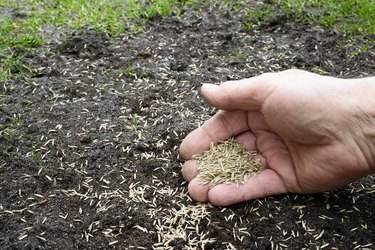
When you're planting grass seed, do you ever feel like most of it gets wasted due to runoff or pesky birds? Do you wish it would sprout in just a day? It's not wishful thinking: You can pre-germinate grass seed for these benefits and more.
Here's how to get it done effectively so you can have a lush, healthy lawn in no time.
Video of the Day
Video of the Day
What Is Pre-germination?
All seeds have a protective layer, called the seed coat, which surrounds the developing embryo and protects the seed's energy storage structures. The seed will remain dormant until water reaches the seed coat, triggering germination. First, the seed coat must be removed before the roots and shoots can grow. In most plants, including turfgrass, the seed coat is removed by water.
Pre-germination exposes seeds to a constant level of water to encourage rapid disintegration of the seed coat. By the time you sow pre-germinated grass seeds, all or most of the seed coat has been removed, and the seedlings will sprout within a day or two.
Benefits of Pre-germinating Grass Seed
Pre-germination doesn't happen overnight. In fact, pre-germination requires up to five days of soaking the seeds. So, why should seeds spend those five days soaking in water instead of laying in the soil?
The main benefit of pre-germination is water conservation. When you water seeds scattered on bare soil, much of the water never touches the seeds. Instead, it's lost to evaporation and has to be replenished often. Pre-germination keeps your water bill comparatively low because you skip that initial week or two of daily watering.
Pre-germination also reduces seed loss. Because pre-germinated grass seed sprouts so quickly, it's less likely to be blown away by the wind, washed away by heavy rain or eaten by birds and squirrels before taking root. This can lead to a lusher lawn overall and could save a bit of money since you don't need to buy extra grass seed or straw mulch.
How to Pre-germinate Grass Seed
Pre-germinating grass seed can be done in just a few simple steps:
- Using the instructions on your seed bag, measure the amount of grass seed you need for the area you want to cover.
- Place the seeds in a breathable bag, like a burlap sack, to make water changes easier.
- Tie a knot in your chosen seed bag to avoid spilling any seeds into the water.
- Fill a clean bucket with room-temperature water.
- Place the seed bag into the water and push it down to ensure water fills the bag and covers all the seeds. The seeds will not rot or get moldy as long as the water is changed frequently. Aim for at least one water change every 24 hours, but every 12 hours is even better.
- To change the water, simply pull out the bag, dump the water and clean the bucket with a mild bleach solution to keep mold and mildew at bay.
- Rinse the bucket thoroughly, refill it and push the seed bag into the fresh water. Allow the seeds to soak for four to five days or until you see the tiny roots begin to grow.
Spreading the Grass Seed
Make sure the planting area is prepared before removing the seed bag from the water so that the seeds don't dry out before they're broadcast. Squeeze out excess water from the bag and place the seeds in your chosen spreader or scatter them by hand. Once the grass seed has been distributed, lightly rake the soil to cover the seeds and then spray the area with water.
A new lawn should be watered every day until the seedlings are about 1 inch tall. Then, you can water every other day for another three weeks to help the grass become established. After that, the grass should only need watering once a week.